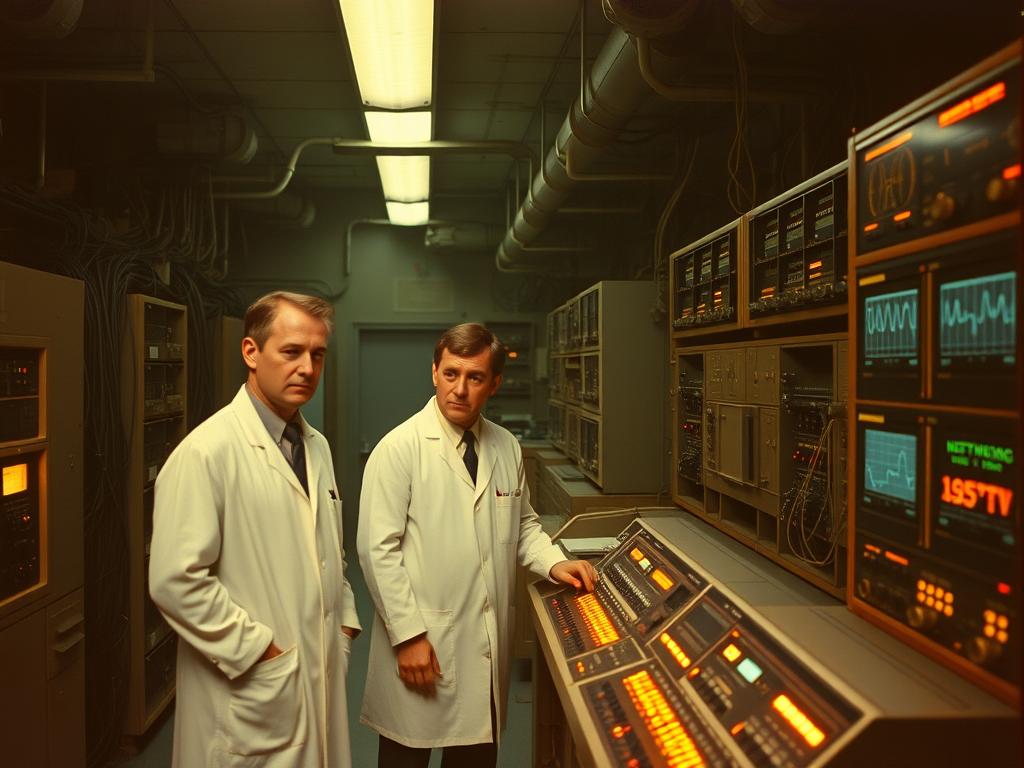Computer networking changed how we communicate globally. It started with engineers and scientists who imagined computers talking across distances. Their ideas laid the groundwork for our digital world today.
The 1950s saw rapid technological growth. Sputnik 1’s launch in 1957 changed U.S. tech policy. The government created NASA and ARPA, which became crucial for developing networking tech.
Vannevar Bush at MIT and Howard Aiken at Harvard made groundbreaking computing systems. Their early computers were key steps towards networked communication. Inventing networks needed teamwork and fresh ideas.
Network history shows how research and military tech came together. It changed isolated machines into connected systems. This shift transformed how we share and process information.
The idea of linked computers slowly became real. It took ongoing research and innovative thinking. These pioneers couldn’t have known how much their work would change human interaction.
The Dawn of Computer Networking: From Vision to Reality
Early computing sparked technological innovation, driven by military needs and scientific ambition. In the 1950s, scientists envisioned interconnected machines that could revolutionise information processing. This vision laid the groundwork for our modern networked world.
The Cold War spurred computational research, pushing the boundaries of possibility. Governments and research institutions poured resources into developing advanced computing systems. These systems aimed to solve complex problems quickly and efficiently.
Early Computing Systems
The late 1950s saw remarkable developments in computational capabilities:
- The U.S. military developed the Semi-Automatic Ground Environment (SAGE) radar system
- Christopher Strachey filed a time-sharing systems patent in the United Kingdom
- John McCarthy initiated the first time-sharing project at MIT
Time-Sharing Systems: A Revolutionary Concept
Time-sharing systems marked a significant leap in computing. These innovative platforms allowed multiple users to access a single computer simultaneously. This breakthrough dramatically increased computational efficiency and accessibility for users.
Cold War’s Technological Catalyst
Cold War tensions inadvertently accelerated technological progress. Military funding and strategic needs drove researchers to develop sophisticated early computing systems. These systems would ultimately transform global communication and information processing.
These pioneering efforts bridged computational limitations and explored networked technologies. They paved the way for the interconnected digital landscape we experience today.
Who Invented the First Computer Network
The first computer network marked a pivotal moment in tech history. ARPANET inventors created a revolutionary digital communication system. Their packet-switching innovation allowed data transmission in small, manageable chunks.
Computer scientists from leading institutions collaborated on this groundbreaking technology. In 1969, the Advanced Research Projects Agency (ARPA) established the world’s first operational computer network.
- Leonard Kleinrock from UCLA
- Bob Taylor from ARPA
- Lawrence Roberts from MIT
- Paul Baran from RAND Corporation
The initial ARPANET linked four university nodes using 50 kbit/s circuits. This innovative system showcased the potential of decentralised communication. It laid the foundation for today’s internet.
These pioneers’ work transformed computer communication, breaking down geographical barriers. Their achievement proved computers could share information rapidly and efficiently. This revolutionary approach paved the way for global digital interaction.
ARPANET: The Groundbreaking Network of 1969
In 1969, ARPANET revolutionised computer networking. This pioneering network connected researchers and institutions in unprecedented ways. It marked a crucial milestone in the development of modern internet technology.
ARPANET’s initial implementation was both ambitious and strategic. The project received $1 million from ballistic-missile defence funds. This investment reflected the fierce technological rivalry during the Cold War era.
The First Four Network Nodes
The first network nodes were established at four groundbreaking locations:
- University of California, Los Angeles
- Stanford Research Institute
- University of California, Santa Barbara
- University of Utah
These institutions were linked using 50 kbit/s circuits. This connection speed was a remarkable advance in early internet protocols.
Technical Innovations and Protocols
ARPANET’s design focused on decentralised communication to prevent single points of failure. Researchers like Taylor and Licklider foresaw the transformative power of networked digital computing. Their collaborative work laid the foundation for future internet technologies.
Military Origins and Civilian Applications
ARPANET began as a military research project. However, its impact soon extended beyond its original purpose. By the early 1970s, the network expanded internationally.
It connected researchers across different continents. This expansion laid the groundwork for our modern interconnected world.
“The Computer as a Communication Device” – A visionary publication that foresaw the global online communities we now take for granted.
The Evolution of Network Technologies in the 1970s
The 1970s saw a revolution in networking, reshaping early internet development. Packet-switching networks emerged, expanding computer communication possibilities. These innovations paved the way for modern connectivity.
- ALOHAnet: A pioneering wireless network from Hawaii
- Telenet: One of the first commercial packet-switching networks
- Tymnet: Another critical network infrastructure platform
Network technologies grew beyond ARPANET’s initial limits. Every computer needed an Interface Message Processor (IMP) to connect. This became a crucial breakthrough in early internet development.
The 1970s were a decade of unprecedented technological collaboration and innovation in networking.
By decade’s end, network protocols had become more sophisticated. This progress laid the groundwork for today’s global internet. Researchers tirelessly overcame communication barriers, creating more efficient networking systems.
The Birth and Rise of Ethernet
Bob Metcalfe’s Ethernet invention changed computer networking forever. In 1973, he wrote a groundbreaking memo at Xerox PARC. This new approach drew inspiration from the University of Hawaii’s Aloha network.
Ethernet hit the market in 1980 and quickly caught on. The IEEE 802.3 standard officially recognised it in 1983. Initial data transfer rates were 2.94 Mbit/s but grew rapidly.
By 1985, 3Com had sold 100,000 Ethernet adapter cards. This showed how popular it had become in corporate networks. Network speeds increased dramatically over the years.
Starting at 10 Mbit/s, Ethernet transformed computing systems. In the early 1990s, most PCs and workstations had Ethernet ports. It replaced other technologies like Token Ring.
Bob Metcalfe predicted Ethernet would become a £100 billion industry by 2013. Today, Ethernet speeds reach 800 Gbit/s, with 1.6 Tbit/s connections in development. Its growth shows remarkable technological progress.











